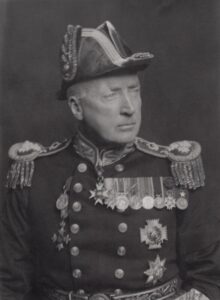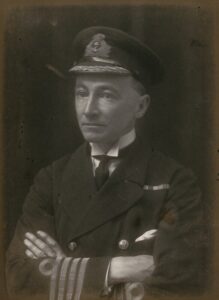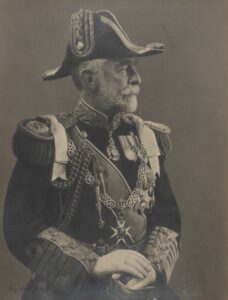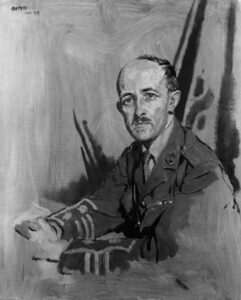Joseph Moretz
Independent Historian
At the conclusion of the Washington Conference in February 1922, statesmen had good reason to feel satisfied at their handiwork.1 A naval arms race amongst recently cooperative belligerents had seemingly been forestalled with the prospect of spending countless millions arrested. This was not peace in our time, but it was a time when sustaining the peace that took forever to come in 1918 still mattered. Legal limitations in capital ship numbers, tonnage and fighting dimensions amongst the five principal naval powers stood without precedent. If failing to remove all barriers to peaceful relations, the Washington Naval Agreement at least possessed the virtue of tackling one obstacle widely perceived to have been a cause of the World War.2
Avowedly, the conference had aimed to achieve far more, but addressing limitations in air and land armaments would have required the presence of others.3 30/5, Balfour telegram No. 59 of 24 November 1921.] Even in the naval sphere the cup remained only half full. Abolition of the submarine or severely restricting its displacement to preclude offensive use—British desires in the wake of the havoc exacted in the recent war—faltered and so too extending the ratio system now agreed for capital ships to cruisers.4 O[ffice] 800/209/14-24, Balfour ‘Opening Remarks,’ 15 November 1921.] The last proved more to British liking as the Royal Navy posited a requirement in cruisers beyond the limits offered by the United States.5
Having conceded naval supremacy without a shot fired in anger, British officers in a dry Washington perhaps might not cheer the results quite so fulsomely, but they too had reason to be thankful, if only because a greater peril had been avoided. To wit, an initial proposal to limit total British and American carrier tonnages to 80,000 tons—roughly equaling present Royal Navy strength—had been modified to a limit of 125,000 tons, thus allowing ample room for future growth.6 Better yet, all existing carriers had been deemed ‘experimental’ and could be replaced by newer types. As only the Royal Navy so far possessed aircraft carriers and the knowledge gained from operating them, future construction would likely confirm the existing advantage.7iralty 1/8735/72, Naval Staff memorandum, 21 November 1921.] Additionally, the trap of opening research establishments, manufacturing plant and naval magazines to outside inspection had been side-stepped. This was no small achievement given Britain’s advantage in Anti-Submarine Warfare painfully acquired and the steps already taken to improve the navy’s ordnance based on war experience.
Much has been written of the Washington Naval Agreement and here one may cite the view of the late Stephen Roskill (made with the full benefit of hindsight) as approaching received wisdom when he avowed:
that of all the ideas hopelessly devised by man to reduce the likelihood of war, and of all measures of alleged economy forced by politicians on the fighting services, the naval limitation treaties will stand for all time not only as the most ineffective, but also the most dangerous to those nations which loyally tried to abide by their restrictive terms.8
That is to claim much—perhaps too much—for it overlooks how the several navies responded to the new strategic setting. Most especially is the case regarding fleet tactics and this essay will address the Royal Navy’s response to the Washington Naval Agreement.
Too be sure, affairs in Washington only confirmed the strategic necessity of a Singapore Naval Base.9 But, a whole lot less has been recorded of the navy’s efforts to address the tactical implications of Washington.10 Thus, with overall parity conceded to the United States and superiority in local waters granted to Japan, the Admiralty sought to redress matters by ensuring tactical proficiency in battle. In truth, the test of the World War had made such a reorientation necessary, never mind the results secured at Washington. Still, the Washington accords only emphasized this trend as recourse to outbuilding an adversary in the near term was forsaken. It was also a step that could proceed minus the intrusion of the cabinet and the Treasury. Indeed, given the woeful performance of the navy during the war, political support for correcting deficiencies in training and doctrine would find ready acceptance.
Foremost, executive officer education remained one area ripe for tackling the fallout of the Washington Naval Treaty with both the Royal Naval War College and the Royal Naval Staff College noting the new realities arising from the Washington Naval Agreement as part of their tuition. As the surviving record is so patchy, drawing definitive conclusions is problematic, especially as the arms control regime was covered more generally in the series of six lectures offered to officers in International Law. In 1926-1927 only a single lecture of the more than ninety provided to officers that year explicitly covered tactics.11 Before that and in 1922, the Washington Naval Agreement had featured as Commander Frederic Bennett’s subject in the extended essay each officer under instruction was required to write as part of the coursework. Following his successful completion of the Staff Course, Bennett remained at Greenwich as a lecturer where he focused on German naval operations during the late war. Thus, not even Bennett evidenced much interest in a matter fundamentally altering British naval circumstances.12
That the Staff College largely ignored the Washington Naval Conference is unsurprising for preparing for the future always retained more resonance for that body than second-guessing the past. The same could be said of the Royal Naval War College where flag officers, captains and commanders learnt the higher aspects of naval warfare. Under Rear Admiral Sir Herbert Richmond, the War College offered a balanced curriculum covering policy, strategy, operations and tactics. Doubtless, this reflected the pedagogical inclinations of that officer where overarching principles and the object of any enterprise remained as constants.13 Washington, however, challenged a key tenet of British naval orthodoxy which readily assumed any war would be fought from a position of maritime superiority. Operationally, this superiority might not always exist in all theaters, but strategically, and over the course of any war, it would tell in the end.
From that superiority had stemmed Britain’s ability to execute amphibious operations by employing second-line units. This had been a feature throughout Britain’s naval past and the admiral now feared the conduct of future combined operations had been gravely compromised. One palliative would have been to ship the supporting troops in transports rather than in older battleships or cruisers, but Richmond viewed that course with disfavor as the transports would not be able to provide the required gunfire support to any assault. Even if that worry had not existed, the problem of how to land tanks remained. Richmond saw ships such as the obsolete HMS Dreadnought as offering an ideal solution. Cut down as razees, the ships could accommodate tanks embarked on the open upper deck and hoisted over the side by the ship’s 20-ton derrick.14
Clearly, a mind closely attuned to the Royal Navy’s past saw possibilities for solving current tactical dilemmas but first the ships had to be available. This included the ability of conducting future blocking operations such as Zeebrugge to neutralize the still very real threat posed by the submarine to surface forces. To Richmond, the greatest problem with the Washington Agreement was that it viewed naval war as a discrete act when in fact it was nations that went to war and not simply navies. This put at risk the very idea of the British way in warfare where projecting the army upon a distant shore had allowed her to damage an enemy in a manner without fear of return.15
Even before Washington, Richmond had cautioned officers to refrain from assuming any fleet encounter would proceed from a position of strength. Such woolly thinking in the present fiscal environment was lethal as a
fighting officer must never permit tactical training to start from the assumption that we shall fight with superior force. The results of doing so are far reaching: action is cramped, risks are avoided, opportunities missed, and officers imagine they can shelter themselves behind the excuse that their numbers were not adequate….16
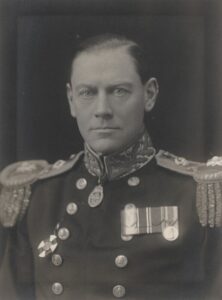
Sir Herbert Richmond, 1921 (National Portrait Gallery, UK – NPG x65624)
In short, owing to the parity conceded to the United States and the burden of distance prevailing in the case of Japan, British assumptions of strategic superiority were no longer tenable. Another quick to appreciate the changed environment was Lieutenant Commander Russell Grenfell. A recently qualified staff officer, Grenfell argued the existing means of tactical instruction were weighted towards mastering the employment of specific weapons rather than securing an appreciation of how best to employ all the means available in battle. The reasons for this gap in understanding were not hard to fathom as the navy spent but little time in mastering tactical theory in either the War College or the Staff College. Thus, in late 1923 Grenfell posited the need for a school dedicated to the study of tactics.17 Russell Grenfell, ‘Training in Tactics,’ Naval Review, Vol. 11, No. 4 (1923): 681-6.]
That Grenfell’s plea fell on deaf ears must not be attributed to the unsoundness of his proposal, for others too believed strategic parity would beget tactical stalemate in battle.18 A recently promoted lieutenant commander and serving in the battleship HMS Iron Duke on the Mediterranean Station, Grenfell may have not been a prophet in the wilderness, but he stood removed from the mainspring of naval policy—the Naval Staff.19
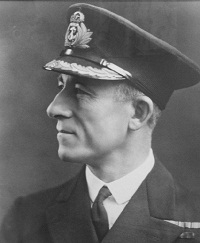
Capt. Russell Grenfell RN (Courtesy of Grenfell Family History)
One more attuned to the corridors of Whitehall was Rear Admiral Frederic Dreyer. Viewed as the service’s leading gunnery expert and erstwhile Flag Captain to Admiral Jellicoe in the Iron Duke at the Battle of Jutland, Dreyer successfully bridged the chasm in personalities that engulfed the service in the wake of that action.20 Viewed as pompous, Dryer was not everybody’s cup of tea being ‘[u]niversally distrusted & disliked in the service’.21 The verdict remained Grenfell’s and allowing that that officer might have retained a special pique, even he recognized Dreyer’s unbounded talent. So too did Beatty who saw Dreyer as an officer of no mean achievement. Shortly, the First Sea Lord would be able to assess such talents more closely as Dreyer joined the Admiralty as Assistant Chief of Naval Staff (ACNS) in September 1924.
In March 1924, however, Dreyer sat in on the Senior Officers’ War Course where he was bold to criticize the paucity of tactical instruction within the navy. As the eighteen-week course that year included at least five lectures on naval tactics,22 it may be that Dreyer’s charge was aimed at the broader service rather than the War Course itself. Be that as it may, Dreyer’s palliative of establishing a dedicated tactical school as a necessary corrective proved too much for his peers.23 In a class that included three flag officers,24 the font of their objections may have stemmed more from the messenger than the message. Yet, the thought of seeing another shore establishment meddling in the affairs of the seagoing fleet and stifling the initiative of afloat admirals should not be discounted, nor that officers deprecated attending courses ashore as this operated against the sea-time required to secure promotion.25 Warming to his subject Dreyer ended his peroration by avowing ‘The Tactical encounter is the culminating act in war and is therefore of supreme importance, for though bad strategy may be redeemed by successful tactics, there is no remedy for defeat in battle.’26
As ACNS and the senior officer responsible for the tactical side of the Naval Staff, Dreyer got the last laugh, because Beatty heartily endorsed the creation of a tactical school.27 The First Sea Lord’s endorsement represented a climbdown of sorts, in that previously Beatty had avowed only material superiority would suffice for the service owing to the many naval secrets that had been shared with the United States Navy during the recent war to the detriment of its tactical advantage.28 Clearly, the present naval holiday and the strategic parity now accepted put support to thoughts of maintaining Britain’s sea supremacy through renewed construction; only recourse to superior technique seemingly remained.
The establishment of the Tactical School in 1925 and the convening of its first course that March proved a watershed for the Royal Navy, though few initially welcomed Dreyer’s child with open arms.29 Its eight-week curriculum directly tied the formal doctrine of the service and the defined capabilities of British ships and aircraft against the presumed attributes of foreign counterparts in mock battle. In time, the school would evaluate specific tactical problems set by the Admiralty to assist in developing effective counters for use in fleet engagements.30 Though it cannot be claimed the school arose only because of the period’s treaty regime—after all, financial stringency remained a fact of life—the regime initiated at Washington made the venue ever the more necessary.
Unsurprisingly, the Admiralty treated the creation of the Tactical School and its curriculum as a closely held secret. Those assigned to the course were noted as enrolled in the ‘Senior Officers’ Technical Course, Part II’ with the school itself operating under the cover of the Navigation School, HMS Dryad. This subterfuge proved difficult to sustain as officers of the Royal Air Force, also attending the course, began to confuse it with another venue, the ‘Senior Officers’ Technical Course, Part I’. Thus, in 1930 the Admiralty formally adopted the title ‘Tactical Course’ in place of the cumbersome appellation ‘Senior Officers’ Technical Course, Part II’.31 Still, evidently one not confused was the United States Navy which quickly learned of the school and its purpose.
Another change following on from the Washington treaty regime was the steady allocation of British front-line naval strength from home waters to the Mediterranean Station. Proposed by the Director of Plans Captain Barry Domvile in February 1922 to address the changed strategic situation, a corollary benefit touted was its aid in tactical training given the better climatic conditions existing there.32
Of course, not all tactical changes stemmed from on high with many originating within the seagoing fleets. Here, the efforts of Admiral Sir Charles Madden, the Commander-in-Chief of the Atlantic Fleet, came to the fore based on his evaluation of fleet exercises. Thus, Madden proposed that the primary objective of British submarines should now be the heavy ships of an enemy fleet and not his mercantile trade as had been enunciated at Washington. This recommendation stemmed from the extraordinarily successful attacks the Third Submarine Flotilla had registered against the Atlantic Fleet’s battle squadrons in exercises off the Balearic Islands.33 Six months later and again drawing upon the lessons of recent Atlantic Fleet serials, Madden noted Britain’s post-Washington battle fleet would not likely exceed twelve ships. Accordingly, he proposed increasing the distance between deployed battleships from 2.5 to four cables ‘with the object of decreasing the risk of hits by torpedoes without increasing the Gunnery Concentration difficulties or unduly increasing the length of the line.’34
Madden’s suggestion soon won approval and though the new cruising arrangement afforded a degree of protection from torpedo attack, the increased distance between divisions proved insufficient to allow a subordinate flag officer ‘to fight his division with real freedom, and without having constantly to consider the movements and distance away of the other divisions.’35
As the presumed superior fleet, the navy had deprecated battle at night between capital ships believing its outcome owed too much to luck. Post-Washington, this stance changed and while that treaty cannot be vouched the sole reason why, parity between fleets gave an impetus to perfecting its performance in a nighttime encounter.36 The gamut of interwar tactical training is well documented in the series Progress in Tactics which recorded the issues under investigation in the many serials executed by the fleets and squadrons of the Royal Navy.37 Many had their origins in shortfalls identified in the surface naval actions of the World War, reflected the incorporation of aircraft in fleet operations, or appeared because Japan was now viewed as the most probable enemy. Yet, other investigations owed their origins to the treaty regime initiated at Washington. Here, one may cite the problem of a British fleet engaging a peer competitor whose force lacked the support of battle cruisers. This reference to the United States Navy foreshadowed that the functions British battle cruisers performed must perforce be conditioned by the relative strength of the opposing battle fleet.38 In all this, Richmond would have approved for as he himself had noted:
While it is the business of the strategist and the organiser to bring a superior force against the enemy at the decisive point, it is the business of the tactician to fight with whatever force he is furnished.39
Looking on from a hundred years, one might conclude that the faith exhibited by statesmen in what had been secured at Washington smacked of naiveté and that it was naval officers such as Dreyer, Grenfell and Richmond who retained a truer appreciation of present verities. Yet, that would be too narrow a reading. The World War remained a haunting legacy for all. This included the United States which might be afforded as having had a ‘good war’. With the proceedings opening on 12 November 1921—the day after an unknown soldier from that war had been interred at Arlington National Cemetery—the magnitude of what followed was not lost on Charles Evans Hughes, Arthur Balfour, and their peers. If they had aspired to do better, then they also accepted that the secured results remained subject to that other verity in international discourse rarely voiced but always present: rebus sic stantibus.40 In sum, the faith of statesmen, no less than professionals, proved more limited with all relying on that other surety: Fear God and dread nought!
(Return to December 2022 Table of Contents)
Footnotes
- Those attending the conference included the United States, Great Britain, Japan, France, Italy, China, Belgium, the Netherlands and Portugal with representatives from India, Canada, Australia and New Zealand attached to the British delegation. ↩
- On the background of the competition in naval armaments see Jonathan Steinberg, Yesterday’s Deterrent: Tirpitz and the Birth of the German Battle Fleet (Aldershot: Gregg Revivals, 1992). ↩
- Namely, Russia and Germany whose latent power France much feared. The French price for considering a reduction in land armaments remained a collective guarantee of defense from the other powers. See The National Archives, Richmond, Surrey, United Kingdom, hereafter, TNA, CAB[inet ↩
- TNA F[oreign ↩
- TNA CAB 30/5, Balfour telegram No. 73 of 28 November 1921. ↩
- The increase became necessary owing to the disadvantage it placed upon France and Italy where they would be limited to operating a single aircraft carrier and, thence none, whilst undergoing refit. ↩
- TNA A[DM ↩
- S. W. Roskill, HMS Warspite: The Story of a Famous Battleship (Annapolis: Naval Institute Press, 1997), 86. ↩
- TNA CAB 23/45/11, Cabinet minutes, 21 February 1923. ↩
- On the background to the Singapore Naval Base see James Neidpath, The Singapore Naval Base and the Defence of Britain’s Eastern Empire 1919-1941 (Oxford: Clarendon Press, 1981). ↩
- Diary entry of 20 October 1927, Charles Harding Drage Papers, Imperial War Museum, London, United Kingdom, PP/MCR/99, Reel 2. Chatham House, more formally then, the Royal Institute of International Affairs. ↩
- TNA ADM 196/126 (F. Bennett) and ADM 203/100, ‘Royal Naval War College, Officers Attending, Essays and Lecturers’. ↩
- On the War College curriculum and the influence of Richmond see the author’s, Thinking Wisely, Planning Boldly: The Higher Education and Training of Royal Naval Officers, 1919-39 (Solihull: Helion & Company Limited, 2014). ↩
- H. Richmond to R. Keyes letter of 30 November 1921 in Paul G. Halpern, ed., The Keyes Papers: Selections from the Private and Official Correspondence of Admiral the Fleet Baron Keyes of Zeebrugge, Volume II (London: George Allen & Unwin Ltd., 1980), 64-6. ↩
- Ibid. ↩
- ‘Tactics,’ Spring 1920, Admiral Sir Herbert Richmond Papers, National Maritime Museum, Greenwich, United Kingdom, NMM/RIC/10/2. ↩
- [Anon. ↩
- ‘Notes on Tactics,’ undated, Admiral Sir William Fisher papers, National Maritime Museum, Greenwich, United Kingdom, NMM/FHR/17. ↩
- TNA ADM 196/54 (R. Grenfell). Grenfell had been earmarked to serve in the Training and Staff Duties Division of the Naval Staff in September 1935, but the appointment was subsequently canceled. ↩
- The assessment was rendered by Jellicoe and seconded by Admirals Chatfield, Walter Cowan, Frederick Field and Henry Oliver over succeeding years; see TNA ADM 196/89 (F. Dreyer). ↩
- R. Grenfell to B. Liddell Hart letter of 2 June 1937, Sir Basil Liddell Hart Papers, Liddell Hart Centre for Military Archives, King’s College, London, LH 1/330/9. ↩
- The estimate is Dreyer’s. See Frederic Dreyer, The Sea Heritage: A Study of Maritime Warfare (London: Museum Press, 1955), 178. ↩
- Ibid, 279. ↩
- To wit, Rear Admirals Vernon Haggard, Christopher Payne and Charles Beaty-Powell; As President of the Royal Naval College Greenwich, Admiral Sir George Hope directed the course. ↩
- D. Pound to H. Richmond letter of 19 January 1925, Richmond Papers, NMM/RIC/7/3a and Barry D. Hunt, Sailor-Scholar: Admiral Sir Herbert Richmond, 1871-1946 (Waterloo: Wilfrid Laurier University Press, 1982), 127. ↩
- TNA ADM 1/8658/69, Dreyer lecture, ‘Study of War & of the Conduct of Naval Operations,’ 23 June 1924. ↩
- Dreyer, Sea Heritage, 279. ↩
- Beatty to Admiralty letter No. 310/H.F. 0050 of 4 April 1919, Admiral Sir Sydney Fremantle Papers, National Maritime Museum, Greenwich, United Kingdom, NMM/FRE/315/315. ↩
- The establishment of the coursed was promulgated to the service via a Confidential Admiralty Fleet Order issued on 19 December 1924; see TNA ADM 182/83, ‘3380.-Tactical Courses-Information as to Institution, etc., To be withheld from Press, Foreign Officers and Public.’ ↩
- See especially TNA ADM 239/142, C.B. 03016/39 Progress in Tactics, Admiralty, Naval Staff, Training and Staff Duties Division, June 1939 and ADM 186/154, C.B. 1769/33(2), Exercises & Operations, 1933, Volume II, Admiralty, Naval Staff, Tactical Division, April 1934, 8. ↩
- TNA ADM 192/89, Confidential Admiralty Fleet Order ‘576.-Senior Officers’ Technical Courses—Change of Name,’ issued 22 February 1930. ↩
- B. Domvile minute of 24 February 1922 in Paul G. Halpern, ed., The Mediterranean Fleet, 1919-1929 (Farnham: Ashgate, 2011), 335-7. ↩
- TNA ADM 116/2173, Commander-in-Chief Atlantic Fleet to Admiralty letter No. 257/A.H. 1124 of 14 August 1922. ↩
- TNA ADM 1/8628/130, Commander-in-Chief Atlantic Fleet to Admiralty letter No. 1119/A.H. 1120 of 14 August 1922. The suggestion was formally adopted in 1927 and specified in Admiralty Fleet Order 2358 of 7 October 1927; see TNA ADM 182/50, Admiralty Fleet Orders. ↩
- C.B. 3016/31, Progress in Tactics, 1931, Admiralty, Naval Staff, Tactical Division, August 1932, 29. ↩
- TNA ADM 1/9411, Chatfield to Naval Staff minute M.F.O. 102/36, 20 March 1936. ↩
- C.B. 3016, Progress in Tactics, Admiralty, Naval Staff, Tactical Division, multiple editions, British Sources Box 12, Naval Historical Center, Washington, DC. ↩
- C.B. 3016/31, Progress in Tactics, 1931, 42. ↩
- Richmond, ‘Tactics,’ Spring Session 1920, Royal Naval War College, Richmond Papers, NMM/RIC/10/2, 28. ↩
- This was the sense of a minute by Hankey at the time; see TNA CAB 30/31, M. Hankey to A. Balfour minute of 3 January 1922. ↩

